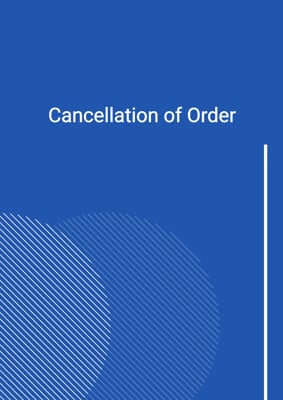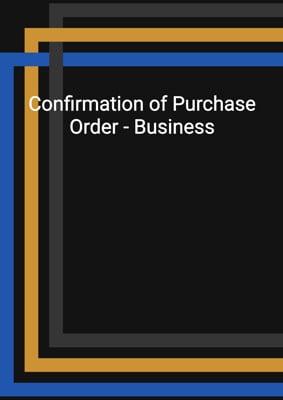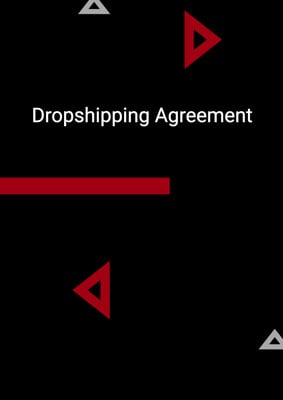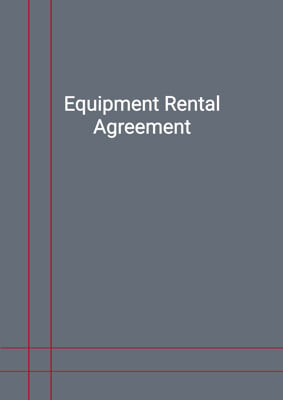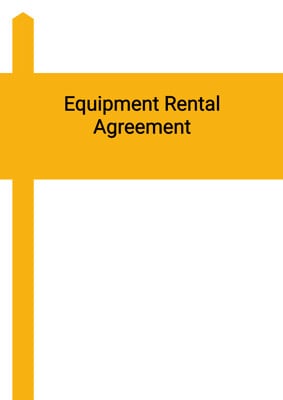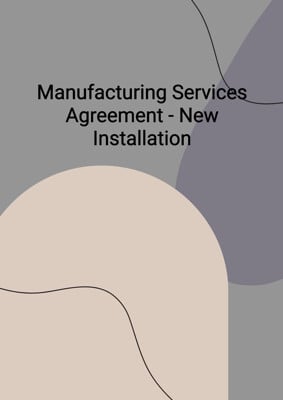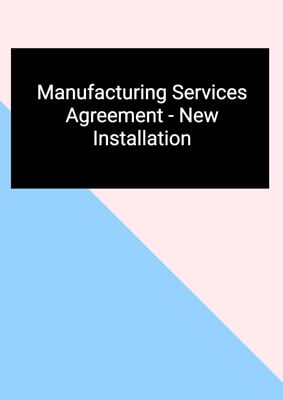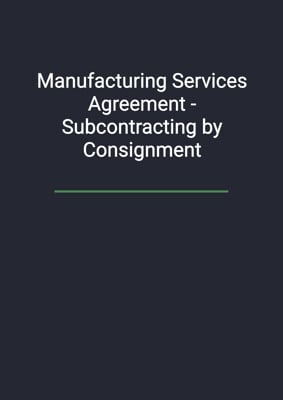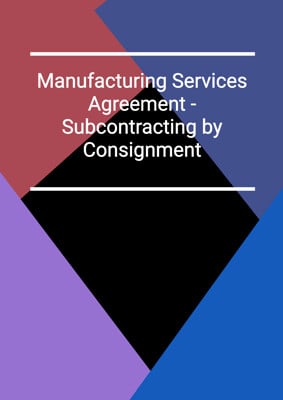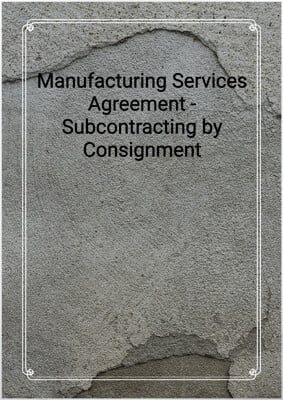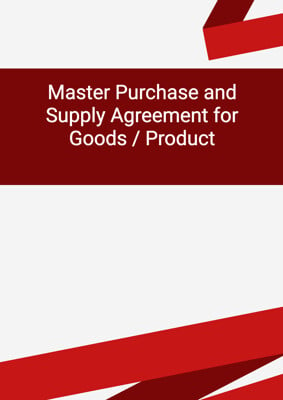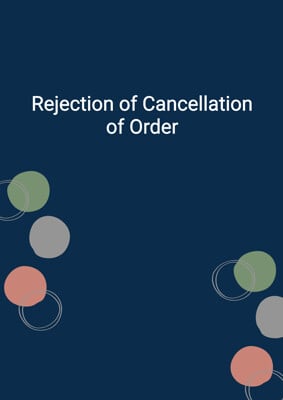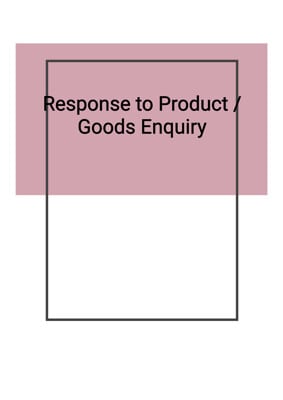
Manufacturing Services Agreement - New Installation
Customer / Client
This Manufacturing Service Agreement is drafted for a Manufacturer to provide manufacturing services to a Client with specific installation and facility requirements, requiring substantial investments by the Manufacturer. This is drafted as a service rather than the sale and purchase of products. This agreement is drafted in favour of the Client.
How to Tailor the Document for Your Need?
01
Create Document
Fill in the details of the parties. You can click the "Fill with Member’s Information" button to complete it with information saved to your account.
02
Fill Information
Please fill in any additional information by following the step-by-step guide on the left hand side of the preview document and click the "Next" button.
03
Get Document
When you are done, click the "Get Document" button and you can download the document in Word or PDF format.
04
Review Document
Please get all parties to review the document carefully and make any final modifications to ensure that the details are correct before signing the document.
Document Preview
Document Description
The Manufacturing Services Agreement - New Installation is a crucial document that outlines the terms and conditions between the manufacturer and the client. This agreement is important as it establishes the relationship between the parties and sets out their respective rights and obligations. It provides a detailed framework for the manufacturing services to be provided by the manufacturer to the client.
The entire document is divided into several sections, each addressing specific aspects of the agreement. The first section, 'Definitions,' provides clear definitions of key terms used throughout the agreement, ensuring that both parties have a common understanding of the terminology.
The second section, 'Conditions Precedents,' outlines the conditions that must be met before the agreement becomes effective. This ensures that both parties have fulfilled their obligations and are ready to proceed with the agreement.
The third section, 'Appointment,' establishes the appointment of the manufacturer by the client to perform various tasks, including the installation, process development, and manufacturing services. It also establishes the formation of a steering committee to oversee the performance of these tasks.
The fourth section, 'Installation,' outlines the responsibilities of the manufacturer in carrying out the installation of the facility. It includes provisions for engaging contractors, ensuring progress and quality of work, and conducting inspections.
The fifth section, 'Process Development and Technology Transfer,' describes the process of developing procedures for manufacturing the products and transferring technology from the client to the manufacturer. It emphasizes the importance of collaboration and cooperation between the parties.
The sixth section, 'Manufacturing Services,' outlines the obligations of the manufacturer to provide exclusive or non-exclusive manufacturing services to the client. It includes provisions for accepting orders, delivering products, and ensuring product quality.
The seventh section, 'Consideration,' specifies the set-up fee and minimum purchase amount to be paid by the client to the manufacturer as consideration for the services provided.
The eighth section, 'Compliance and Audit,' highlights the manufacturer's obligation to comply with all relevant laws and regulations and allows the client to conduct audits to ensure compliance.
The ninth section, 'Intellectual Property Rights,' addresses the ownership and use of intellectual property by both parties. It includes provisions for licensing, assignment, and protection of intellectual property.
The tenth section, 'Confidential Information,' establishes the obligations of both parties to keep confidential any information disclosed during the course of the agreement. It includes exceptions for publicly available information and information required to be disclosed by law.
The eleventh section, 'Disclosure of Intellectual Property,' outlines the client's obligation to disclose intellectual property to the manufacturer and restricts the publication or disclosure of such information without prior written consent.
The twelfth section, 'Maintenance of Records,' requires the manufacturer to maintain records related to the provision of services and deliver them to the client upon termination of the agreement.
The thirteenth section, 'Limitation on Liability,' excludes certain warranties and conditions and specifies the client's responsibility for product recalls.
The fourteenth section, 'Indemnity and Insurance,' establishes the manufacturer's obligation to indemnify the client for losses and expenses arising from claims related to product use. It also addresses the requirement for insurance coverage.
The fifteenth section, 'Term and Termination,' specifies the term of the agreement and the conditions under which either party can terminate the agreement. It includes provisions for payment upon termination.
The sixteenth section, 'Assignment and Sub-contracting,' restricts the assignment or subcontracting of the agreement without prior written consent.
The seventeenth section, 'Patent and Copyright Indemnity,' requires the manufacturer to indemnify the client against any infringement of intellectual property rights.
The eighteenth section, 'Amendments,' allows for the amendment or modification of the agreement with written consent from both parties.
The nineteenth section, 'Severability,' ensures that if any provision of the agreement is deemed void or unenforceable, the remaining provisions will still be valid.
The twentieth section, 'Notices,' specifies the requirements for giving notice under the agreement, including the methods of delivery and addresses of the parties.
The twenty-first section, 'English Language,' states that all notices and communications must be in English or accompanied by an English translation.
The twenty-second section, 'Settlement of Disputes,' encourages the parties to resolve any disputes amicably. If a dispute cannot be resolved, it provides for dispute resolution through negotiation and, if necessary, through legal means.
The twenty-third section, 'Counterparts,' allows the agreement to be executed in multiple counterparts, with each counterpart considered an original.
The twenty-fourth section, 'No Rights for Third Parties,' clarifies that only the parties to the agreement have rights under it and that third parties cannot enforce its terms.
The agreement also includes several schedules, such as the design of the facility installation, product specifications, background intellectual property, price and payment details, necessary information and material, and acceptance tests. These schedules provide additional details and specifications related to the agreement.
Overall, the Manufacturing Services Agreement - New Installation is a comprehensive and detailed document that covers all aspects of the manufacturing services to be provided by the manufacturer to the client. It ensures clarity, protection of intellectual property, compliance with laws, and establishes a framework for cooperation and communication between the parties.
How to use this document?
To use the Manufacturing Services Agreement - New Installation effectively, follow these steps:
1. Familiarize yourself with the definitions provided in the agreement. This will ensure a common understanding of the terms used throughout the document.
2. Ensure that all conditions precedents have been met before proceeding with the agreement. This includes finalizing the design of the installation as per Schedule A.
3. Establish a steering committee comprising representatives from both parties to oversee the installation, process development, and technology transfer.
4. Engage contractors approved by the client to carry out the installation. Ensure timely payment of all amounts due to the contractors.
5. Monitor the progress and quality of the installation. If unsatisfied with any contractor's work, provide written notice and allow a reasonable period for improvement or rectification.
6. Notify the client at least 14 days before the expected completion of the installation. Allow the client to inspect the facility and identify any defects that need to be rectified.
7. Collaborate with the client to develop procedures for manufacturing the products and transfer technology as outlined in Clause 6.
8. Provide exclusive or non-exclusive manufacturing services to the client as agreed upon. Accept orders within 30 days and deliver products as per the agreed incoterms.
9. Ensure that all products supplied are of merchantable quality, free from defects, and compliant with the specifications.
10. Allow the client to inspect the manufacturing services and products. Promptly remedy any defects identified by the client.
11. Maintain comprehensive insurance coverage for the performance of your obligations under the agreement, if required.
12. Comply with all applicable laws and regulations and cooperate with any audits conducted by the client.
13. Respect the intellectual property rights of the client and obtain necessary licenses for the use of background intellectual property.
14. Keep all confidential information disclosed during the agreement confidential and disclose it only as required by law or with the client's consent.
15. Maintain records related to the provision of services and deliver them to the client upon termination of the agreement.
16. Indemnify the client for any losses or expenses arising from claims related to product use, unless the claims result from the client's breach or negligence.
17. Terminate the agreement in accordance with the specified conditions, if necessary. Ensure prompt delivery of background intellectual property and any requested documentation.
18. Seek legal advice if disputes arise and attempt to resolve them amicably. If resolution is not possible, follow the dispute resolution process outlined in the agreement.
By following these steps, you can effectively use the Manufacturing Services Agreement - New Installation and ensure compliance with its terms and conditions.
Not the right document?
Don’t worry, we have thousands of documents for you to choose from:
